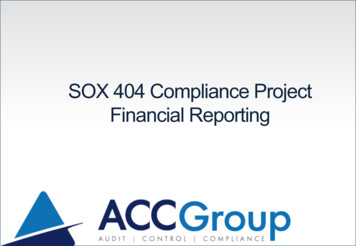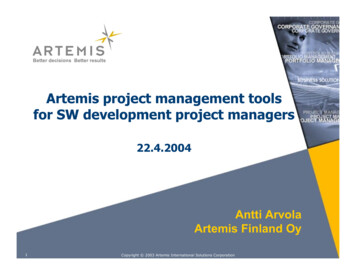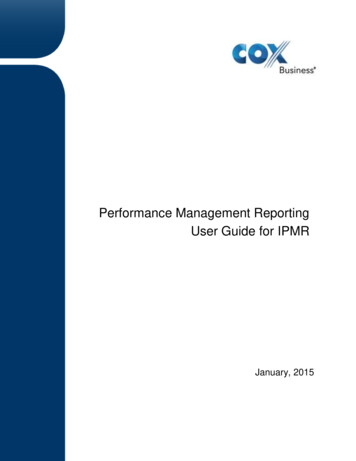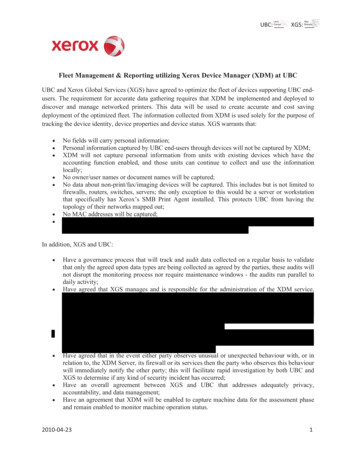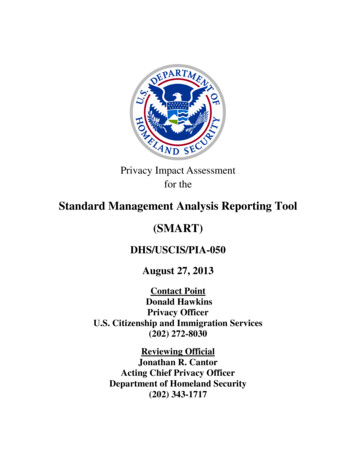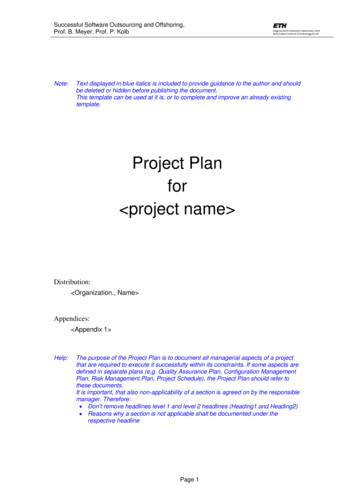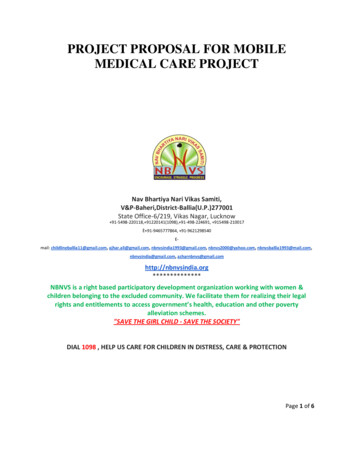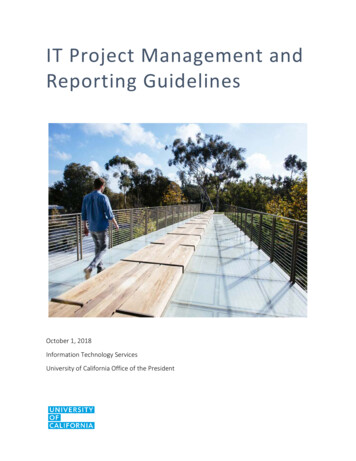
Transcription
IT Project Management andReporting GuidelinesOctober 1, 2018Information Technology ServicesUniversity of California Office of the President
IT Project Management and Reporting GuidelinesTable of Contents1. Introduction52. Regents Reporting Requirements73. Project Development Guidelines133.1 Integrated Schedule and Resource Plan133.2 Assessing Schedules for Reasonableness153.3 Cost Reporting173.4 Risk Management203.5 Change Management233.6 Independent Verification and Validation (IV&V)254. Contract Deliverable Expectation Document27Appendix29References30A downloadable version of this document is available on the University of California InformationTechnology Leadership Council website.
IT Project Management and Reporting Guidelines1. IntroductionThe University of California (UC) is committed to ensuring that significant IT projects across alluniversity locations are managed following established best practices. The UC IT ProjectGuidelines (Guidelines) establish high-level requirements for managing IT projects costing 5Mor more. It seeks to promote a professional and consistent university-wide approach to IT projectmanagement. All locations are required to integrate these Guidelines into their local practices.AudienceThe Guidelines are not in any way intended to serve as an introduction to or overview of projectmanagement principles and best practices. Rather, they are designed for project managementprofessionals – both managers and project team practitioners at all UC locations – responsible fordirectly performing or overseeing project management processes and activities. Suchexperienced professionals are positioned to readily interpret and implement these Guidelines.PurposeThe specific project management processes and practices selected for inclusion in the Guidelinesare those considered most critical for ensuring effective IT project management at UC. To thisend, the information and advice presented emphasizes the importance of processes, people skills,good judgement, and effective communication. The Guidelines are designed to focuspractitioners on essential project management processes deemed critical to success, and do notprovide in-depth or prescriptive instructions.The fundamental reason to pursue a consistent approach to IT project management across thedecentralized university system is to ensure that university resources spent on significant ITprojects – those projected to cost 5 million or more – are wisely managed. Indeed, policyestablished in 2017 mandates reporting to the UC Regents about all IT projects with an estimatedor actual cumulative cost of 5 million or more. Regents Policy 5103 thus draws new focus to ITproject costs, outcomes, and project management effectiveness. At the 5 million threshold, itbecomes paramount that the university: Ensure adherence to professional project management practices to optimize theexpenditure of public resources, Implement processes that support standardized reporting and the effective oversightof IT projects at the system-wide level, Provide useful information to Project Sponsors and Project Stakeholders, and Enable resource sharing and collaboration across locations to encourage optimal useof funding and development of expertise.10/01/182. Regents Reporting Requirements 5
IT Project Management and Reporting GuidelinesStructure and ResourcesThe content of the Guidelines was derived from a number of sources, including the CaliforniaState Department of Technology. Further, project managers from UC campuses providedfeedback and comment. The chapters of the Guidelines cover: Project scheduling and resource management, Cost reporting, Risk management, Change management and Vendor deliverable management.Various templates are provided to illustrate how each process can be documented and managed,and should be treated as examples and resources. Project management practitioners areencouraged to leverage the templates by modifying them to fit the needs of their respectivelocations and projects.UpdatesWhile the Office of the President maintains the Guidelines, a community of IT projectmanagement professionals will be turned to for input and direction in updating the Guidelinesperiodically to align with industry best practices and with experience from implementation,ensure that the Guidelines maintain relevance and help the university meet its stated goals.10/01/182. Regents Reporting Requirements 6
IT Project Management and Reporting Guidelines2. Regents Reporting RequirementsTo ensure that the University of California Board of Regents is able to exercise necessaryoversight for the university's significant IT projects, all University locations are required perRegents Policy 5103 to provide a status update to the Regents three times per calendar year on ITprojects with an estimated or actual cumulative cost of 5M or more.The 5M threshold: Includes costs for in-kind labor (e.g., existing staff) and billable labor (e.g., contractors,UC recharge labor) Excludes ongoing cost of operations Excludes savings projectionsTwo types of reports are to be submitted to UCOP for reporting to the Regents:1. Summary report for each project with an estimated/actual cumulative cost between 5M and 25M. The template for the summary report contains only the following elements:a. Campus locationb. Project namec. Budget (current approved)d. Begin date (current projected or actual)e. End date (current projected or actual2. Comprehensive report for each project with an estimated/actual cumulative cost of 25M ormore. The template for the comprehensive report utilizes a standard one-page report formatand includes the following elements:a. Project Description and Purposeb. Overall Health Statusc. Risk Statusd. Budget Statuse. Schedule Statusf. Top Issuesg. Scope Changesh. Recent Accomplishmentsi. Planned Accomplishments for Next Reporting Period10/01/182. Regents Reporting Requirements 7
IT Project Management and Reporting GuidelinesEach location is responsible for preparing its own reports. Completed reports must be submittedusing the templates provided and are sent to the Office of the President for consolidation andsubmission to the Regents.Additional instructions and submission deadlines are contained in the appendix.Appendix ItemsRegents Report Submission Timeline and InstructionsReport Period Ending DateDate Report Due to UCOPDec 31Feb 1Apr 31Jun 15Aug 31Oct 15Regents Presentation DateMar 14/15in-personJul 31mailing onlyNov 30mailing onlyRefer to the University of California Information Technology Leadership Council website forreport submission instructions and contact information.10/01/182. Regents Reporting Requirements 8
IT Project Management and Reporting GuidelinesSummary Report Template and SampleUse the Summary Report template for projects with an estimated or actual cumulative budgetbetween 5M and 25M.Summary Report TemplateClick here for a downloadable copyLocationProject NameBudget ( MM)Start DateEnd DateSummary Report SampleBudget( MM)LocationProject NameStart DateEnd DateUC-wide 504UC Irvine HealthUCPathUCePic - UC electronic Patient InformationCollaborationOct 2011Jun 2019 UC IrvineUCI Student Information System Replacement 82Jul 2016Nov 201770Jan 2015Jul 2020UC-wideUC MercedRedwoodFireEye Cybersecurity Threat Detection &IntelligenceCapital Projects (Downtown Campus Center &Project 2020): FF&E for active electronics 51Jan 2015Apr 2020 23May 2016Dec 2017 22Sep 2017Sep 2020UC Davis HealthEHR Hosting - Marshall Medical Center 22Jul 2016Nov 2017UC San DiegoStudent Information System renewal 19Jan 2019Jun 2020UC Davis HealthePic Beaker 18Jul 2015Feb 2018UC Davis HealthMaterials Management 16Jan 2015Mar 2018UC San Francisco HealthPrecision Cancer Medical Building (PCMB) 16Jun 2016Apr 2019UC Merced 12Sep 2014Sep 2020UC RiversideNext Gen Network UpgradeBanner: Student System Upgrade from IBM basedto Oracle based platform 11Sep 2012Oct 2016UC San Francisco HealthUCSF Data Center Migration 11Nov 2015Jun 2018UC San DiegoFinancial Information System renewal 10Apr 2016Jun 2019UC San Diego HealthePic EMR Module additions 8Jul 2016May 2018UC Santa CruzTelecommunications Infrastructure UpgradeEnterprise Imaging (VNA: Vendor NeutralArchive) 7Apr 2016Sep 2020 6Feb 2017Apr 2018 5Oct 2017Dec 2019UC MercedConsolidated Financial Reporting replacementENABLE: Campus data store & data warehouse tosupport campus-wide reporting strategy 5TBDTBDUC MercedeProcurementin planningDec 2017TBDUCLA/UCM/UCOPFinancial System Replacementin planningJan 2018Jul 2020UC-wideUC HealthUC-wide10/01/182. Regents Reporting Requirements 9
IT Project Management and Reporting GuidelinesComprehensive Report Template, Instructions, and SampleUse the Comprehensive Report template for projects with an estimated or actual cumulativebudget of 25M or more.Comprehensive Report TemplateClick here for a downloadable copyComprehensive Report Sample10/01/182. Regents Reporting Requirements 10
IT Project Management and Reporting GuidelinesComprehensive Report Template Instructions10/01/182. Regents Reporting Requirements 11
IT Project Management and Reporting GuidelinesComprehensive Report Template Instructions, continued10/01/182. Regents Reporting Requirements 12
IT Project Management and Reporting Guidelines3. Project Development Guidelines3.1 Integrated Schedule and Resource PlanThe Integrated Project Schedule (IPS) is a powerful time-based, planning, control, andcommunications tool. It provides a snapshot of both the project’s progress at any given point intime, as well as a view of what lies ahead. It includes resource requirements and serves as thesingle master schedule that everyone uses.Creating a well-developed IPS involves activities such as planning, identification, analysis,documentation, and prioritization of work. When properly executed, the IPS optimizes overallproject execution by enabling activity tracking and reporting, data driven decision making, andwork-stream coordination. In addition, it supports time and cost estimates, facilitatescommunications among personnel involved in project activities, and establishes a commitment tothose activities.Living Document, Care & Feeding RequirementsThe IPS is a living document that once created, needs to be continuously updated to reflect theprogress of, and changes to the project. To ensure its effectiveness as both a tool and a report, itis necessary to define processes and to allocate resources with the requisite skill sets to build,maintain, and report against it.Master Plan Includes All ActivitiesAs the master plan, the IPS serves as the single control point for the entire schedule and resourcemanagement process. This helps ensure that all sub-teams are driving toward the samecompletion dates and that resource coordination is optimized.For the IPS to be effective, it needs to reflect all activities (and their interdependencies andresource requirements), regardless of whether they are the responsibility of the university,contractor, sub-contractor, vendors, or others.Logical SequencingAll activities and their interdependencies (predecessor and successor activities) should belogically sequenced. The sequencing is crucial as it supports usability, and demonstrates howwell the project is structured - if it’s realistic and executable, and if the planned tasks areachievable within time and cost constraints.Resource InformationFor the IPS to be accurate and valid, it must contain resource information. Knowing the amountand type of resource needed and the availability during the desired timeframe is crucial. Whenadding resource information, include descriptive data that clearly defines the skill mix andquantity of resources assigned.4/30/183.1 Integrated Schedule & Resource Plan 13
IT Project Management and Reporting GuidelinesCollaborative CreationDuring the creation process, collaboration with major stakeholders is a key activity that helpsensure that the IPS is comprehensive and reflects all work-streams in totality.Internal participants include core project team members, end users, and service support groupssuch as operations and purchasing. Outside collaborators may range from vendors to nicheconsultants and other external parties such as union representatives.Project Management Team, Primary UsersAlthough the needs of all stakeholders are considered when the IPS is created, give extraattention to the requirements of its primary users – the project management team. This is theteam who uses the schedule on a daily basis to manage the work effort and report on its progress.Baseline after Stakeholder ApprovalsAll key stakeholders - including sponsors, business partners and resource owners –need toapprove and sign off on the IPS. This ensures they have read the schedule, understand the datesand resource commitments, and cooperate. Confirmation that resources will be available asoutlined in the schedule is also vital. The schedule should only be finalized after approval andcommitment for the resource assignments outlined in it is received. Once approved, the schedulecan be baselined and used to determine if the project is on course as planned.Rigorous Ongoing ManagementThe greater the size and complexity of the project, the more important that a well-defined, wellmanaged IPS is in place. While using one will not guarantee success, operating without one orfailing to keep it current will increase the risk of missing deliverables, dates and budgetarylimits.Maintain the discipline to manage the IPS on an ongoing basis. A well-managed scheduleprovides visibility into the project’s health and facilitates an analysis of how changes to scope,schedule delays, unplanned resource consumption, or insufficient staffing levels could impactdeliverables, timelines and budget.The Schedule Management PlanA Schedule Management Plan should be utilized to document the approach for managing allschedule-related activities and functions. It describes
01.10.2018 · more. The template for the comprehensive report utilizes a standard one-page report format and includes the following elements: a. Project Description and Purpose b. Overall Health Status c. Risk Status d. Budget Status e. Schedule Status f. Top Issues g. Scope Changes h. Recent Accomplishments i. Planned Accomplishments for Next Reporting Period
